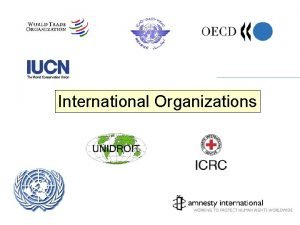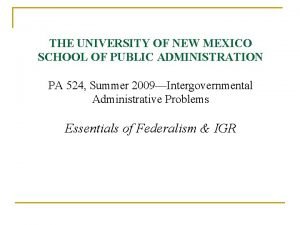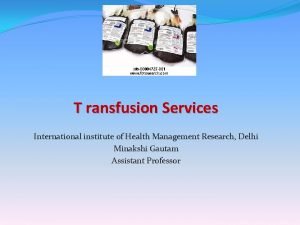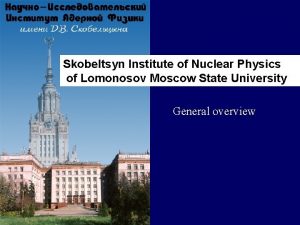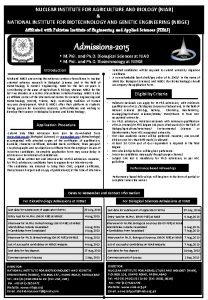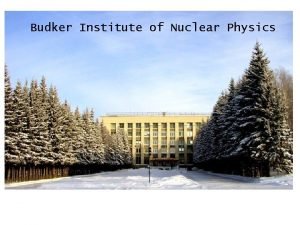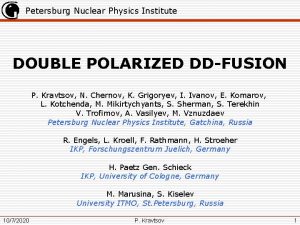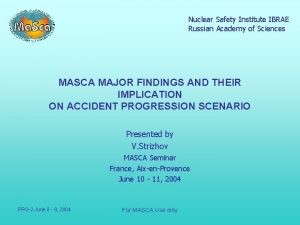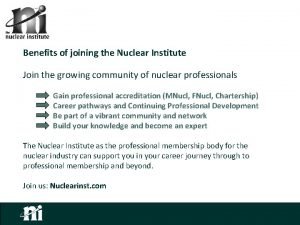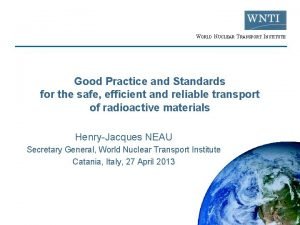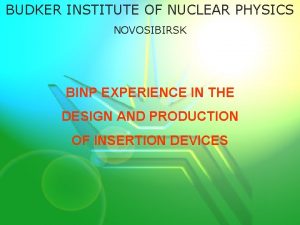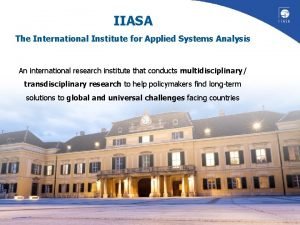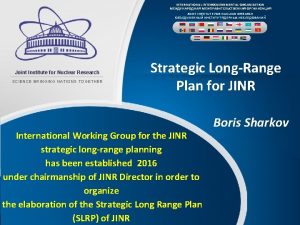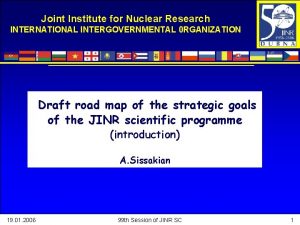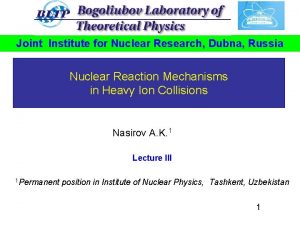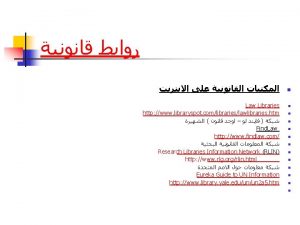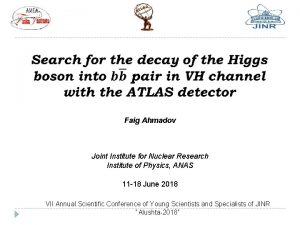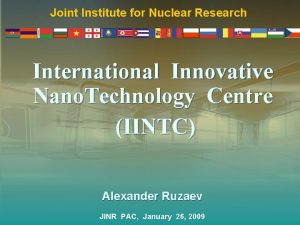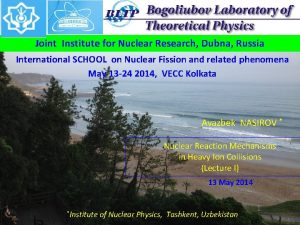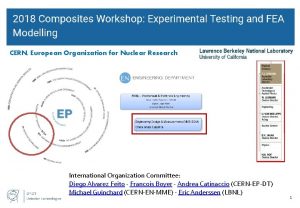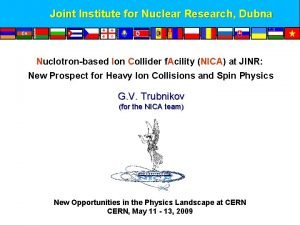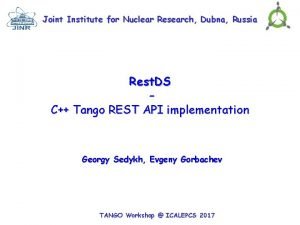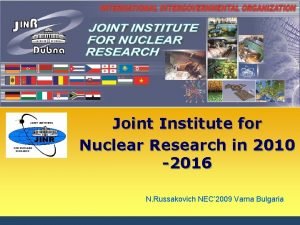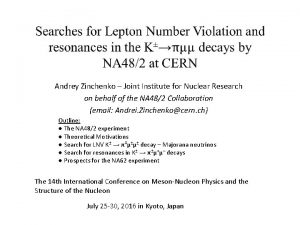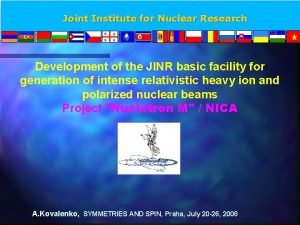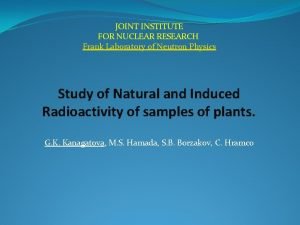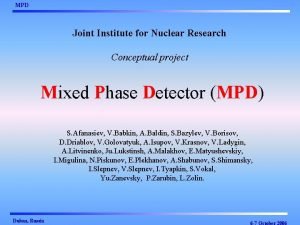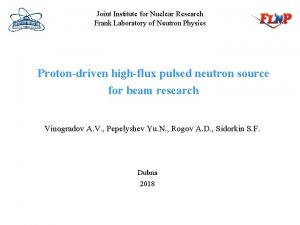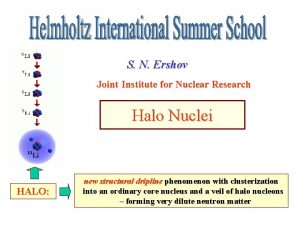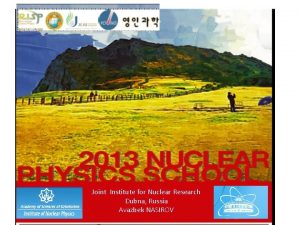Joint Institute for Nuclear Research International Intergovernmental Organization








![9 Collider general parameters B max [ T m ] Ion kinetic energy (Au 9 Collider general parameters B max [ T m ] Ion kinetic energy (Au](https://slidetodoc.com/presentation_image_h2/7db3dffe5ea02193b2142e15701c0a11/image-9.jpg)




















- Slides: 29

Joint Institute for Nuclear Research International Intergovernmental Organization Dedicated to the memory of Alexei Norairovich Sissakian Heavy ion program at NICA@JINR A. S. Sorin (for the NICA/MPD collaboration) Hard Probes 2010, Eilat, October 12

Nuclotron-based Ion Collider f. Acility (NICA) Goals: q Exploration of the QCD phase diagram - in-medium properties of hadrons & nuclear matter equation of state - onset of deconfinement & chiral symmetry restoration - phase transitions, mixed phase & critical phenomena J. Randrup, J. Cleymans - local parity violation (P-odd effects) NICA/MPD Triple point? q Spin physics - to shed light on the origin of spin - to define the nucleon spin structure Collider fixed target Nuclotron 2

Nuclotron-based Ion Ion. Colliderf. Acility(NICA) Flagship New flagship project at JINR/Dubna Basedon onthe thetechnological development Nuclotron facility Based developmentofofthe theexisting Nuclotron facility Optimalusageof of the existing infrastructure Optimal infrastructure Modernmachine which incorporates new concepts Modern newtechnological concepts Operational~~2016 2015 Operational NICA advantages: optimal energy s. NN = 4 -11 (system of max. density) optimal range energy range s. NN Ge. V = 4 -11 Ge. V (system of baryon max. baryon density) rich nomenclature of colliding systems (fromtop+p to Au+Au) rich nomenclature of colliding systems (from p+p Au+Au) 27 -2 -1 79+ 27 cm -2 s-1 cm 79+)Au high luminosity (up to 10 s for ) high luminosity (up to 10 for Au

NICA will provide: 1 a) Heavy ion colliding beams 197 Au 79+ s. NN = 4 ÷ 11 Ge. V Laverage= 1 E 27 cm-2 s-1 (at s. NN = 9 Ge. V) 1 b) Light-Heavy ion colliding beams 2) Polarized beams (collider mode): p p spp = 12 ÷ 27 Ge. V d d s. NN = 4 ÷ 13. 8 Ge. V Laverage 1 E 30 cm-2 s-1 (at spp = 27 Ge. V) 3) Beams of light ions and polarized protons and deuterons (fixed target mode): Li Au = 1 4. 5 Ge. V /u ion kinetic energy p, p = 5 ÷ 12. 6 Ge. V kinetic energy d, d = 2 ÷ 5. 9 Ge. V/u ion kinetic energy 4) Applied research on ion beams at kinetic energy from 0. 5 Ge. V/u up to 12. 6 Ge. V (p) and 4. 5 Ge. V /u (Au)

5 Energy regions (present and future experiments) Ecm , Ge. V/u 2 5 10 15 20 colliders Le. RHIC Au NICA Au fixed target Nuclotron Au NA 49 Pb SIS 18 U 1 SIS 100 Au 3 SIS 300 10 20 kin Elab, Ge. V/u 50 100 200

6 Veksler & Baldin Laboratory of High Energy Physics accelerator facility Collider FT experiment area New Linac Lu 20 Booster Nuclotron

MPD 2. 5 m 4. 0 m Fixe exp d targe erim t ents Booster KRION-6 T & HILac SPI & LU-20 (“Old” linac) Coll C~ ider 500 m Synchrophasotron yoke Nuclotron beam transfer line Spin Physics Detector (SPD) Nuclotron Beam transfer lines & New research area NICA layout (preliminary) 7

Heavy Ion Mode: Operation Regime & Parameters (preliminary) Injector: 2× 109 ions/pulse of 197 Au 32+ at 6. 2 Me. V/u Collider (45 Tm) Storage of 26 bunches by ~ 1 x 109 ions per ring at 1 - 4. 5 Ge. V/u, electron and/or stochastic cooling Booster (25 Tm) 1(2 -3) single-turn injection, storage of 2∙ (4 -6)× 109, acceleration up to 100 Me. V/u, electron cooling, acceleration up to 600 Me. V/u Stripping (80%) 197 Au 32+ => 197 Au 79+ IP-1 Two SC collider rings IP-2 2 х26 injection cycles Nuclotron (45 Tm) injection of one bunch of 1. 1× 109 ions, acceleration up to 1 - 4. 5 Ge. V/u max. 8
![9 Collider general parameters B max T m Ion kinetic energy Au 9 Collider general parameters B max [ T m ] Ion kinetic energy (Au](https://slidetodoc.com/presentation_image_h2/7db3dffe5ea02193b2142e15701c0a11/image-9.jpg)
9 Collider general parameters B max [ T m ] Ion kinetic energy (Au 79+), [Ge. V/u] Dipole field (max), [T] Free space at IP (for detector) Beam crossing angle at IP Vacuum, [ Torr ] Luminosity per one IP, cm-2∙s-1 45. 0 1. 0 4. 56 2. 0 9 m 0 10 -11 0. 02÷ 5. 0 ∙ 10^27

Experiments at Nuclotron-N could cover the energy range between SIS-18 and AGS Extracted beam Max Tkin , Ge. V/u proton (Z/A=1) 12. 0 deutron (Z/A=1/2) 6. 0 Au (Z/A=0. 4) 4. 56 Extracted Nuclotron beams (plan): proton, deutron, neutron, ions (up to Au), polarized proton, deutron, neutron Physics program is complementary to ones at NICA/MPD, SPD

Comparison, particles per cycle Beam Energy GSI (SIS 18) Nuclotron-M (2010) Nuclotron-N (2012) New ion source + booster (2014) p 4, 5 Ge. V 5 1011 8 1010 5 1011 5 1012 d 2, 2 Ge. V 2 1010 8 1010 5 1011 5 1012 4 He 2 109 3 1010 1 1012 d 2 108 7 1010 (SPI) 7 Li 6+ 7 109 3 1010 5 1011 12 C 6+ 300 Me. V 7 1010 6 109 3 1010 3 1011 14 N 7+ 300 Me. V 1 1011 3 107 3 108 5 1010 24 Mg 12+ 300 Me. V 5 1010 7 108 4 109 5 1010 40 Ar 18+ 300 Me. V 6 1010 8 106 2 109 2 1010 4 106 2 109 5 1010 56 Fe 28+ 58 Ni 26+ 300 Me. V 8 109 84 Kr 34+ 0, 3 -1 Ge. V 2 1010 2 105 1 108 1 109 124 Xe 48/42+ 0, 3 -1 Ge. V 1 1010 1 105 7 107 1 109 181 Ta 61+ 1 Ge. V 2 109 1 108 1 109 197 Au 65/79+ 238 U 28+ 3 109 0, 05 -1 Ge. V 5 109

Ø Baryonic Matter@Nuclotron Physics: q AA-interactions - particle production, including sub-threshold production; - studies of particle (collective) flows, even-by-event fluctuations, correlations - phase space distribution of p, n, pi, K, hyperons, light nuclear fragments, vector mesons, resonances - ratios of yields (pi/K) in different kinematic regions q p. A, n. A, d. A interactions in direct & inverse (Ap, Ad) kinematics - to get a “reference” data set for comparison with AA - to study particle modifications in hadronic matter - to study of polarization effects in particle production off nuclear target by polarized d, p, n.

13 Baryonic Matter@Nuclotron Schedule (preliminary) Start of project preparation 2010 q presentation for the consideration at PAC 2011 q Experimental area preparation major subdetector for the starting kit are prototyped & mounted 2012 q starting kit commissioning 2013 q Start of physics runs 2014 q

MPD: 3 stages of putting into operation 14 2 -nd stage IT, EC-subdetectors Forward spectrometer-B 3 -d stage F-spectrometers (optional ? ) 1 -st stage barrel part (TPC, Ecal, TOF) + ZDC, FFD, BBC, magnet, … Toroid universal detector for collider experiments; a central part inserted into 0. 5 T superconducting solenoid (D=5 m, L=8 m)

List of Tasks for MPD. . To measure a large variety of signals at systematically changing collision parameters (energy, centrality, system size). Reference data (i. e. p+p) will be taken at the same experimental conditions. bulk observables (hadrons): 4 particle yields (OD, EOS) multi-strange hyperon production : yields & spectra (OD, EOS) electromagnetic probes (CSR, OD) azimuthal charged-particle correlations (LPV) event-by-event fluctuation in hadron productions (CEP) q correlations involving , K, p, Λ (OD) q directed & elliptic flows for identified hadron species (EOS, OD) q ……. q q q NICA White Paper (http: //nica. jinr. ru) Round Table materials (http: //jinr. ru/theor/) 15

16 Angle coverage of MPD TPC (| | <2) SNN = __3 __9 Ge. V/u ECAL (| |<1. 2) FD (2<| |<4) TOF (| |<3) IT (| |<2. 5) ZDC (| |>3) B = 0. 5 T

Spin Physics NICA design allows to reach effectively polarized • protons up to s ~ 26 Ge. V with average L = 2 1030 cm 2/s • deuterons up to s ~ 12 Ge. V with the average L= 1029 cm-2 s-1 The SPD (Spin Physics Detector) program includes: • Drell-Yan/MMT processes • J/ production processes • Spin effects in elastic p p , p d & d d scattering • Spin effects in inclusive high-p. T reactions • Polarization effects in heavy ions collisions The 1 -st stage could be started already at MPD essential extension of COMPASS (CERN SPS) program 17

Round Table Discussions on NICA@JINR Round Table Discussion I: Searching for the mixed phase of strongly interacting matter at the JINR Nuclotron, July 7 - 9, 2005 http: //theor. jinr. ru/meetings/2005/roundtable/ Round Table Discussion II: Searching for the mixed phase of strongly interacting matter at the JINR Nuclotron: Nuclotron facility development JINR, Dubna, October 6 - 7, 2006 http: //theor. jinr. ru/meetings/2006/roundtable/ Round Table Discussion III: Searching for the mixed phase of strongly interacting QCD matter at the NICA: Physics at NICA JINR (Dubna), November 5 - 6, 2008, http: //theor. jinr. ru/meetings/2008/roundtable/ Round Table Discussion IV: Searching for the mixed phase of strongly interacting QCD matter at the NICA: Physics at NICA (White Paper) JINR (Dubna), September 9 - 12, 2009 http: //theor. jinr. ru/meetings/2009/roundtable/ Round Table Discussion V: Searching for the mixed phase of strongly interacting QCD matter at the NICA: Physics at NICA (White Paper) JINR (Dubna), August 28, 2010 http: //theor. jinr. ru/~cpod/Dubna_2010_program 2. htm

Editorial board: D. Blaschke D. Kharzeev A. Sissakian A. Sorin O. Teryaev V. Toneev I. Tserruya http: //theor. jinr. ru/twiki-cgi/view/NICA/Web. Home

Contents (55 contributions) 1 General aspects (6) 2 Phases of QCD matter at high baryon density (16) 3 Femtoscopy, correlations and fluctuations (7) 4 Mechanisms of multi-particle production (6) 5 Electromagnetic probes and chiral symmetry in dense QCD matter (6) 6 Local P and CP violation in hot QCD matter (6) 7 Cumulative processes (2) 8 Polarization e�ects and spin physics (3) 9 Related topics (3) 10 References

The NICA White Paper 114 authors from 46 scientific centers in Arizona State University, USA University of Oslo, Norway Los Alamos National Laborator 19 Countries (8 JINR members) Lulea Technical University, Sweden Lebedev Institute, Russia University of Illinois, USA St. Petersburg SU, Russia Wayne SU, USA LBNL, USA Kurchatov Institute, Russia IHEP, Russia JINR Dubna Columbia University, USA ITEP, Russia BNL, USA INP MSU, Russia Ohio SU, USA MEPh. I, Russia BITP, Ukraine INFN, Italy Osaka University, Japan Tel Aviv University, Israel SISSA, Italy YITP Kyoto, Japan University of Catania, Italy Variable Energy Cyclotron Centre, India University of Trento, Italy University of Florence, Italy INR, Russia Weizmann Institute, Israel Rio de Janeiro University, Brazil GSI Darmstadt, Germany FIAS Frankfurt, Germany University of Barselona, Spain University of Frankfurt, Germany University of Coimbra, Portugal University of Giessen, Germany Mateja Bela University, Slovakia Wroclaw University, Poland Jan Kochanovski University, Poland Institute of Applied Science, Moldova University of Cape Town, South Africa University of Bielefeld, Germany Tsinghua University, Beijing, China Beijing Institute of High Energy Physics, China Lanzhou National Laboratory of Heavy Ion Accelerator, China http: //theor. jinr. ru/twiki-cgi/view/NICA/Web. Home

Chiral vortaic effect and neutron asymmetries at NICA O. Rogachevsky, A. Sorin, O. Teryaev (ar. Xiv: 1006. 1331 and poster presentation HP 2010) Both, chiral magnetic effect (CME) and chiral vortaic effect (CVE) belong to the class of effects based on the triangle anomaly in QFT. CVE is a generalization to conserved charges other than the electric one. In case of baryon charge and chemical potential, it should manifest itself by neutron asymmetries, observable at NICA/MPD! Observable: three-particle correlator: In CME case at RHIC: 15 M events were sufficient to establish the effect For demonstrating the CVE, we need 1000 M events, which can be collected at NICA/MPD within a few months of running time!

Summary The NICA/MPD design passed the phase of concept formulation and is presently under ü detailed simulation of NICA/MPD parameters ü development of working project ü manufacturing and construction of prototypes ü Physics program will be extended to Nuclotron energy range and call for proposals is announced The Project realization plan foresees a staged construction and commissioning of NICA/MPD elements. The main goal is the NICA/MPD commissioning in 2016. The collaboration around the NICA/MPD is growing. New members are welcome! 23

Thank you for attention!

NICA construction schedule 2010 2011 2012 2013 2014 2015 2016 ESIS KRION LINAC + channel Booster + channel Nuclotron-M → NICA Channel to collider Collider Diagnostics Power supply Control systems Cryogenics MPD Infrastructure R&D Design Manufactrng Mount. +commis. Commis/opr Operation

The NICA Collaboration Budker INP ü ü Booster RF system Booster electron cooler Collider RF system Collider SC magnets IHEP (Protvino): Injector Linac FZ Jűlich (IKP): HV E-cooler & Stoch. cooling Fermilab: HV E-cooler, (expertise) ü HV e-cooler for collider ü Electronics ü Injector linac (under discussion) Beam dynamics, Stoch. cooling CERN: Beam dynamics, E-cooling, Acceler. technique BNL (RHIC) Electron & Stoch. Cooling All-Russian Institute for Electrotechnique HV Electron cooler GSI/FAIR SC dipoles for Booster/SIS-100 SC dipoles for Collider ITEP: Beam dynamics in the collider Corporation “Powder Metallurgy” (Minsk, Belorussia): Technology of Ti. N coating of vacuum chamber walls for reduction of secondary emission

27 Timetable MPD

28 MPD Collaboration + Nuclotron-M/NICA/MPD/SPD cooperation Members of the Collaboration q. Joint Institute for Nuclear Research § JINR ~ 100 q Institute for Nuclearinstitutes Research, RAS, § Other 54 RF q Bogolyubov Institute for Theoretical Physics, NAS, Ukraine q Nuclear Physics Institute of MSU, RF Institutions q Institute Theoretical & Experimental Physics, RF q St. Petersburg State University, RF § JINR q Institute of Applied Physics, from AS, Moldova § 12 institutes 7 countries q Institute for Nuclear Research & Nuclear Energy BAS, Sofia, Bulgaria q Institute for Scintillation Materials, Kharkov, Ukraine q State Enterprise Scientific & Technolog Research Institute for Apparatus construction, Kharkov, Ukraine q Particle Physics Center of Belarusian State University, Belarus The Collaboration is permanently growing q Department of Engineering Physics, Tsinghua University, Beijing, China q Physics Institute Az. AS, Azerbaidjan New participants – are welcome !

Particle yields in Au+Au collisions √s. NN = 7. 1 Ge. V (10% central) 29 Luminosity L = 1027 cm-2 s-1 Event rate (central) 7 k. Hz Particle (mass) Multiplicity decay mode yield (s-1) yield 10 w K+ (494) 55 -- 7. 7· 103 4. 6· 1010 K- (494) 16 -- 2. 2· 103 1. 3· 1010 ρ (770) 23. 6 e+ e- 1. 6· 10 -2 9. 4· 104 ω (782) 14. 2 e+ e- 1. 4· 10 -2 8. 6· 104 φ (1020) 2. 7 e+ e- 1. 1· 10 -2 6. 8· 104 Ξ- (1321) 2. 4 Λπ- 67 4. 0· 108 Ω- (1672) 0. 16 ΛK- 1. 5 9. 2· 106 D 0 (1864) 7. 5· 10 -4 K + π- 2. 0· 10 -4 1200 J/ψ (3097) 3. 8· 10 -5 e+ e- 8. 0· 10 -5 480
 Igo organisation
Igo organisation Intergovernmental child support
Intergovernmental child support Intergovernmental relations definition ap gov
Intergovernmental relations definition ap gov Deil wright models of intergovernmental relations
Deil wright models of intergovernmental relations St clair county intergovernmental grants department
St clair county intergovernmental grants department Lesson 15 nuclear quest nuclear reactions
Lesson 15 nuclear quest nuclear reactions Fisión nuclear vs fision nuclear
Fisión nuclear vs fision nuclear International institute of health management research
International institute of health management research Skobeltsyn institute of nuclear physics
Skobeltsyn institute of nuclear physics Nuclear institute for agriculture and biology
Nuclear institute for agriculture and biology Budker institute of nuclear physics
Budker institute of nuclear physics Petersburg nuclear physics institute
Petersburg nuclear physics institute Nuclear safety institute of the russian academy of sciences
Nuclear safety institute of the russian academy of sciences Nuclear institute membership
Nuclear institute membership World nuclear transport institute
World nuclear transport institute Budker
Budker Conclusion on topic family
Conclusion on topic family Spool joint lamb
Spool joint lamb Hyaline cartilage vertebrae
Hyaline cartilage vertebrae Semi permanent joining methods
Semi permanent joining methods Memorandum joint venture account format
Memorandum joint venture account format Lamb grading chart
Lamb grading chart Ellipsoid joint
Ellipsoid joint Biblical discipleship principles
Biblical discipleship principles International institute of christian discipleship
International institute of christian discipleship Viristan
Viristan Excellentia international institute
Excellentia international institute International institute for applied system analysis
International institute for applied system analysis International institute of christian discipleship
International institute of christian discipleship Process organization in computer organization
Process organization in computer organization
